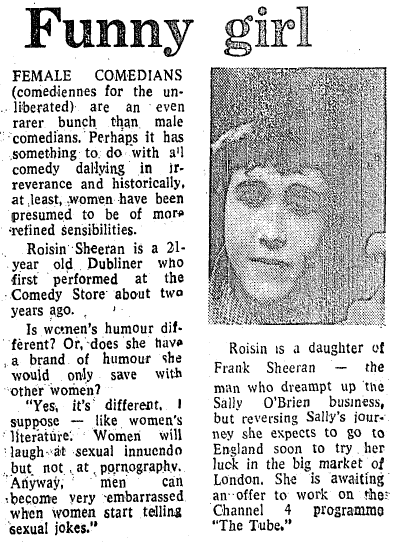Today, stand-up comedy is a multi-million Euro business. Comics like Dara O’Briain and Tommy Tiernan regularly do stints of ten or more nights in Vicar Street, Michael McIntyre can sell out The 02 twice over, dozens of comedians release DVDs for the Christmas market and a whole range of venues like The Laughter Lounge on Eden Quay, The Comedy Cellar at The International, Stand Up at Bankers pub and The Ha’Penny Bridge Inn offer people seven nights a week of comedy.
This wasn’t always the case.
From the late 1970s to the late 1980s comics struggled to establish comedy nights in the upstairs of pubs, backrooms of hotels and theatres in the city. The history of stand-up comedy in Ireland is quite an overlooked subject (we do use that phrase a lot on this blog) and besides Deirde Falvey and Stephon Dixon’s fantastic Gift of the Gag: The Explosion in Irish Comedy (1999), nothing has really been written on the topic.
Particularly interesting and forgotten is the development of Irish stand-up from the birth of ‘alternative comedy’ in the late 1970s to the establishment of The Comedy Cellar in The International Bar on Wicklow Street in 1988. The groundwork that a small number of people did in these early years helped to nurture and progress the scene to what it is now.
The 1970s were, in many ways, dark times for comedy in this country. The first so-called Festival of Humour took place in May 1978 in Virginia, Co. Cavan. Things can be summed up by the fact that the chairman of the festival committee was the local priest Fr. Pat Morris.
These were the days of Hal Roach at the Jury’s Irish Cabaret and Jimmy O’Dea.
Coinciding with this brand of boring, ‘king of blarney’ Irish comedy a new generation of jokers were beginning to assert themselves, particularly in the Dram Socs and Rag Weeks of the island’s colleges. In the early 1970s in UCD Billy McGrath/Magra, Paddy Murray and Brendan Martin formed a sketch group called The Spike Milligan Comedy Machine known simply as The Machine. Dermot Morgan (of Father Ted fame) wasn’t too far behind and later performed as Big Gom and The Imbeciles in Theatre L.
Spurred on by the explosion (a revolution even?) of intelligent, often anarchic, progressive stand-up (coined by Tony Allen as ‘Alternative Comedy’) in London’s Comedy Store by comics such as Alexi Sayle, Andy de la Tour and Pauline Melville and in The Comic Strip which soon followed by comics such as Rik Mayall, Ade Edmondson, Nigel Planer and French & Saunders – stand up comics in Dublin began testing the water and starting up their own nights.

A review of Billy McGrath’s one-man comedy show ‘An otter you can’t diffuse’. Irish Press. May 9, 1979.
It has been said that Dublin’s first-ever stand-up comedy club was set up in Harcourt Street in the very late 1970s by a Scottish performance artist called Oscar McLennan.
In January 1981, novelist Peter O’Connor launched the Comedy Store at the Holyrood Hotel, Harcourt Street. It seems to have lasted only a few months.
Billy McGrath (Billy Magra) started up Club Comedy in the Sportman’s Inn in Mount Merrion in February 1982. There were further gigs in The Project Arts Centre on East Essex Street, McGonagle’s on South Anne Street, The Mansion House on Dawson Street. The gigs featured Michael Redmond, Kevin McAleer, Ian MacPherson, Mannix Flynn, ‘new wave’ poet Roisin Sheeran, Helen Morrissey, Owen Roe (aka Ronald Raygun), Peter Howick, Garrett Keogh, The Robots (David Rogers and Gerry Sammon), mime group Friends Electric and impressionist Gerry Lavelle.
Sharing the same venues and many of the same values, this exciting new brand of ‘alternative comedy’ ruffled the feathers of the established comedy scene as much as Punk did to music.
In 1984, the Comedy Store (Dublin) ambitiously released its own live LP

Image from the LP – The Comedy Store (Dublin) Live At the Project. Recorded October 1983. Released 1984. Picture: “Gerry Lavelle, Ronald Raygun, Michael Redmond, Roisin Sheeran, Billy Magra (Missing Ian Mac Pherson – in London and Helen Morrissey – in hiding)”
The 13-track LP was recorded live at the Project Arts Centre by Eerie Music Mobile, engineered by Johnny Byrne and Peter Eades, mixed and edited by Slimmer Twins and produced by Stand Treasual (aka Billy McGrath). The executive producer was MCD’s Dennis Desmond.
Slowly but surely modern ‘alternative’ stand-up comedy began to be assert itself, influence a whole new generation and gain credibility. By the late 1980s, this opened up the path for Mr. Trellis (Ardal O’Hanlon, Barry Murphy & Kevin Gildea) and The Quack Squad (Joe Rooney & Paul Tylak) to open up The Comedy Cellar in The International Bar.
Thus starting the next chapter of Dublin’s stand-up history…



















 Click on the book for more.
Click on the book for more. Click on the book for more.
Click on the book for more.